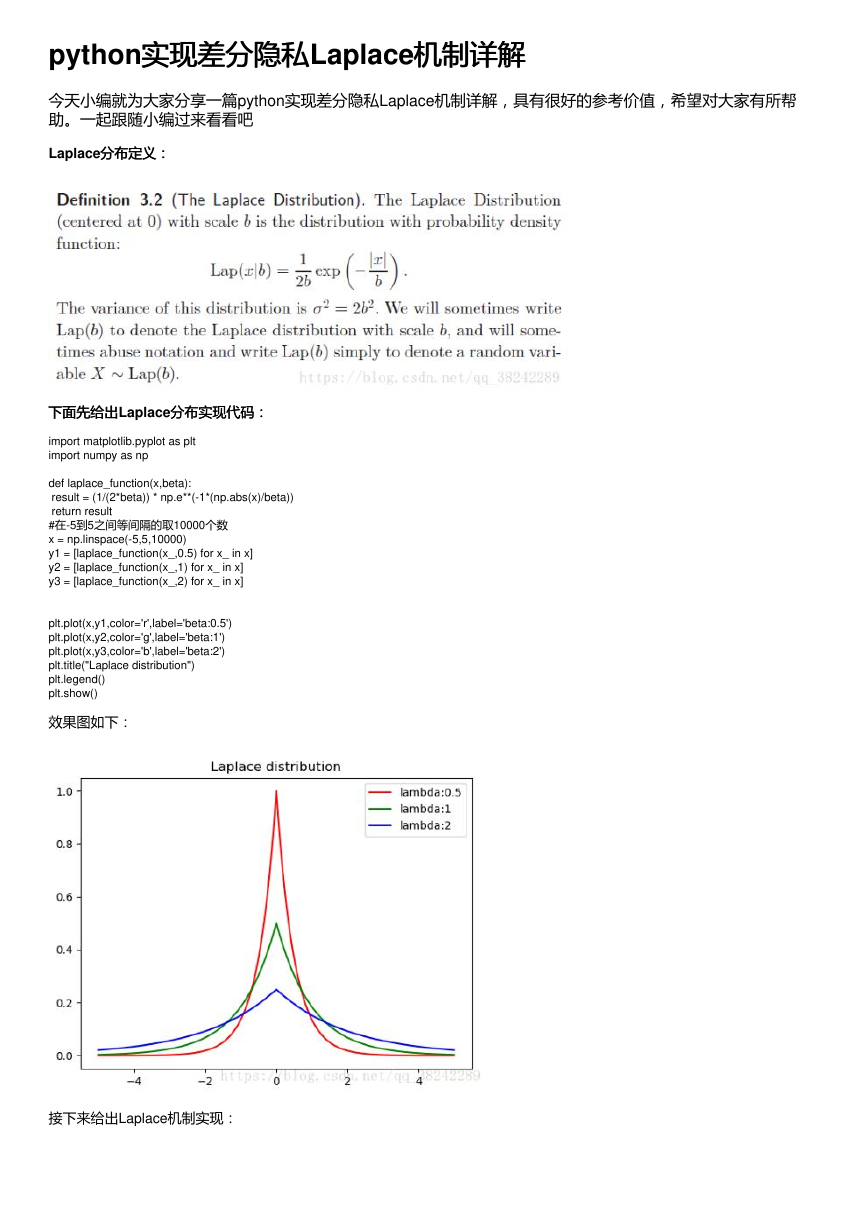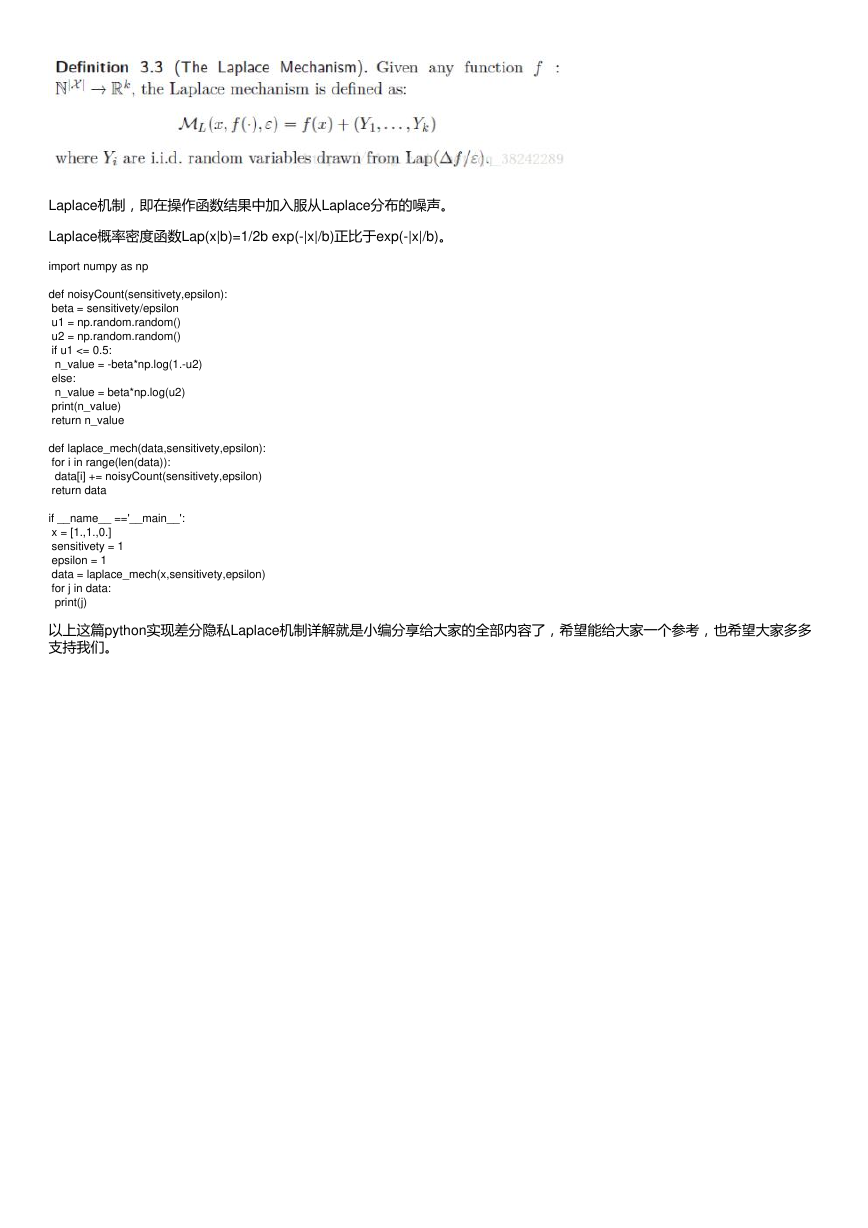实现差分隐私Laplace机制详解
机制详解
python实现差分隐私
今天小编就为大家分享一篇python实现差分隐私Laplace机制详解,具有很好的参考价值,希望对大家有所帮
助。一起跟随小编过来看看吧
Laplace分布定义:
分布定义:
下面先给出Laplace分布实现代码:
下面先给出
分布实现代码:
import matplotlib.pyplot as plt
import numpy as np
def laplace_function(x,beta):
result = (1/(2*beta)) * np.e**(-1*(np.abs(x)/beta))
return result
#在-5到5之间等间隔的取10000个数
x = np.linspace(-5,5,10000)
y1 = [laplace_function(x_,0.5) for x_ in x]
y2 = [laplace_function(x_,1) for x_ in x]
y3 = [laplace_function(x_,2) for x_ in x]
plt.plot(x,y1,color='r',label='beta:0.5')
plt.plot(x,y2,color='g',label='beta:1')
plt.plot(x,y3,color='b',label='beta:2')
plt.title("Laplace distribution")
plt.legend()
plt.show()
效果图如下:
接下来给出Laplace机制实现:
�
Laplace机制,即在操作函数结果中加入服从Laplace分布的噪声。
Laplace概率密度函数Lap(x|b)=1/2b exp(-|x|/b)正比于exp(-|x|/b)。
import numpy as np
def noisyCount(sensitivety,epsilon):
beta = sensitivety/epsilon
u1 = np.random.random()
u2 = np.random.random()
if u1 <= 0.5:
n_value = -beta*np.log(1.-u2)
else:
n_value = beta*np.log(u2)
print(n_value)
return n_value
def laplace_mech(data,sensitivety,epsilon):
for i in range(len(data)):
data[i] += noisyCount(sensitivety,epsilon)
return data
if __name__ =='__main__':
x = [1.,1.,0.]
sensitivety = 1
epsilon = 1
data = laplace_mech(x,sensitivety,epsilon)
for j in data:
print(j)
以上这篇python实现差分隐私Laplace机制详解就是小编分享给大家的全部内容了,希望能给大家一个参考,也希望大家多多
支持我们。
�




 2023年江西萍乡中考道德与法治真题及答案.doc
2023年江西萍乡中考道德与法治真题及答案.doc 2012年重庆南川中考生物真题及答案.doc
2012年重庆南川中考生物真题及答案.doc 2013年江西师范大学地理学综合及文艺理论基础考研真题.doc
2013年江西师范大学地理学综合及文艺理论基础考研真题.doc 2020年四川甘孜小升初语文真题及答案I卷.doc
2020年四川甘孜小升初语文真题及答案I卷.doc 2020年注册岩土工程师专业基础考试真题及答案.doc
2020年注册岩土工程师专业基础考试真题及答案.doc 2023-2024学年福建省厦门市九年级上学期数学月考试题及答案.doc
2023-2024学年福建省厦门市九年级上学期数学月考试题及答案.doc 2021-2022学年辽宁省沈阳市大东区九年级上学期语文期末试题及答案.doc
2021-2022学年辽宁省沈阳市大东区九年级上学期语文期末试题及答案.doc 2022-2023学年北京东城区初三第一学期物理期末试卷及答案.doc
2022-2023学年北京东城区初三第一学期物理期末试卷及答案.doc 2018上半年江西教师资格初中地理学科知识与教学能力真题及答案.doc
2018上半年江西教师资格初中地理学科知识与教学能力真题及答案.doc 2012年河北国家公务员申论考试真题及答案-省级.doc
2012年河北国家公务员申论考试真题及答案-省级.doc 2020-2021学年江苏省扬州市江都区邵樊片九年级上学期数学第一次质量检测试题及答案.doc
2020-2021学年江苏省扬州市江都区邵樊片九年级上学期数学第一次质量检测试题及答案.doc 2022下半年黑龙江教师资格证中学综合素质真题及答案.doc
2022下半年黑龙江教师资格证中学综合素质真题及答案.doc